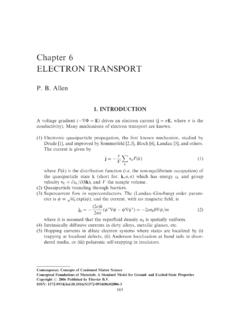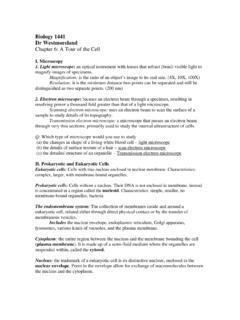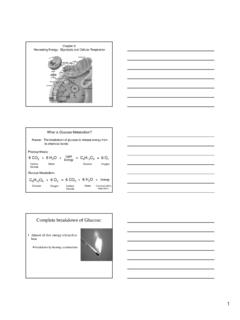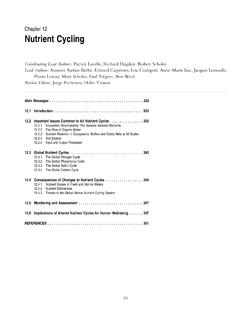Transcription of CHAPTER 13
1 206 BIOLOGYAll animals including human beings depend on plants for their food. Haveyou ever wondered from where plants get their food? Green plants, infact, have to make or rather synthesise the food they need and all otherorganisms depend on them for their needs. Green plants carry out photosynthesis , a physico-chemical process by which they use lightenergy to drive the synthesis of organic compounds. Ultimately, all livingforms on earth depend on sunlight for energy. The use of energy fromsunlight by plants doing photosynthesis is the basis of life on is important due to two reasons: it is the primary sourceof all food on earth. It is also responsible for the release of oxygen into theatmosphere by green plants. Have you ever thought what would happenif there were no oxygen to breath? This CHAPTER focusses on the structureof the photosynthetic machinery and the various reactions that transformlight energy into chemical DO WE KNOW?
2 Let us try to find out what we already know about photosynthesis. Somesimple experiments you may have done in the earlier classes have shownthat chlorophyll (green pigment of the leaf), light and CO2 are required forphotosynthesis to may have carried out the experiment to look for starch formationin two leaves a variegated leaf or a leaf that was partially covered withblack paper, and one that was exposed to light. On testing these leavesfor starch it was clear that photosynthesis occurred only in the greenparts of the leaves in the presence of IN HIGHER PLANTSCHAPTER do weKnow? doesPhotosynthesistake place? manyPigments areinvolved inPhotosynthesis? is LightReaction? are theATP and NADPHUsed? The C4 (19/01/2015)PHOTOSYNTHESIS IN HIGHER PLANTS207 Another experiment you may have carried outis the half-leaf experiment, where a part of a leaf isenclosed in a test tube containing some KOH soakedcotton (which absorbs CO2), while the other half isexposed to air.
3 The setup is then placed in light forsome time. On testing for starch later in the twohalves of the leaf, you must have found that theexposed part of the leaf tested positive for starchwhile the portion that was in the tube, testednegative. This showed that CO2 was required forphotosynthesis. Can you explain how thisconclusion could be drawn? EXPERIMENTSIt is interesting to learn about those simpleexperiments that led to a gradual development inour understanding of Priestley (1733-1804) in 1770performed a series of experiments that revealed theessential role of air in the growth of green , you may recall, discovered oxygen in1774. Priestley observed that a candle burning ina closed space a bell jar, soon gets extinguished(Figure a, b, c, d). Similarly, a mouse wouldsoon suffocate in a closed space. He concluded thata burning candle or an animal that breathe the air,both somehow, damage the air.
4 But when he placed a mint plant in thesame bell jar, he found that the mouse stayed alive and the candlecontinued to burn. Priestley hypothesised as follows: Plants restore tothe air whatever breathing animals and burning candles you imagine how Priestley would have conducted the experimentusing a candle and a plant? Remember, he would need to rekindle thecandle to test whether it burns after a few days. How many differentways can you think of to light the candle without disturbing the set-up?Using a similar setup as the one used by Priestley, but by placing itonce in the dark and once in the sunlight, Jan Ingenhousz (1730-1799)showed that sunlight is essential to the plant process that somehowpurifies the air fouled by burning candles or breathing in an elegant experiment with an aquatic plant showed thatin bright sunlight, small bubbles were formed around the green partswhile in the dark they did not.
5 Later he identified these bubbles to be ofoxygen. Hence he showed that it is only the green part of the plants thatcould release oxygen.(a)(c)(b)(d)Figure Priestley s experiment2015-16(19/01/2015)208 BIOLOGYIt was not until about 1854 that Julius von Sachs provided evidencefor production of glucose when plants grow. Glucose is usually stored asstarch. His later studies showed that the green substance in plants(chlorophyll as we know it now) is located in special bodies (later calledchloroplasts) within plant cells. He found that the green parts in plants iswhere glucose is made, and that the glucose is usually stored as consider the interesting experiments done by Engelmann(1843 1909). Using a prism he split light into its spectral componentsand then illuminated a green alga, Cladophora, placed in a suspensionof aerobic bacteria.
6 The bacteria were used to detect the sites of O2evolution. He observed that the bacteria accumulated mainly in the regionof blue and red light of the split spectrum. A first action spectrum ofphotosynthesis was thus described. It resembles roughly the absorptionspectra of chlorophyll a and b (discussed in section ).By the middle of the nineteenth century the key features of plantphotosynthesis were known, namely, that plants could use light energyto make carbohydrates from CO2 and water. The empirical equationrepresenting the total process of photosynthesis for oxygen evolvingorganisms was then understood as:CO H OCH O OLight2222+ +[]where [CH2O] represented a carbohydrate ( , glucose, a six-carbonsugar).A milestone contribution to the understanding of photosynthesis wasthat made by a microbiologist, Cornelius van Niel (1897-1985), who,based on his studies of purple and green bacteria, demonstrated thatphotosynthesis is essentially a light-dependent reaction in whichhydrogen from a suitable oxidisable compound reduces carbon dioxideto carbohydrates.
7 This can be expressed by:222222H A COA CH O H OLight+ ++In green plants H2O is the hydrogen donor and is oxidised to O2. Someorganisms do not release O2 during photosynthesis. When H2S, insteadis the hydrogen donor for purple and green sulphur bacteria, the oxidation product is sulphur or sulphate depending on the organismand not O2. Hence, he inferred that the O2 evolved by the green plantcomes from H2O, not from carbon dioxide. This was later proved by usingradioisotopic techniques. The correct equation, that would represent theoverall process of photosynthesis is therefore:61266226 12 622 COH OC H O H O OLight+ ++where C6 H12 O6 represents glucose. The O2 released is from water; thiswas proved using radio isotope techniques. Note that this is not a single2015-16(19/01/2015)PHOTOSYNTHESIS IN HIGHER PLANTS209reaction but description of a multistep process called you explain why twelve molecules of water as substrate are usedin the equation given above?
8 DOES PHOTOSYNTHESIS TAKE PLACE?You would of course answer: in the green leaf or you may add, in thechloroplasts based on what you earlier read in CHAPTER 8. You aredefinitely right. Photosynthesis does take place in the green leaves of plantsbut it does so also in other green parts of the plants. Can you name someother parts where you think photosynthesis may occur?You would recollect from previous unit that the mesophyll cells in theleaves, have a large number of chloroplasts. Usually the chloroplasts alignthemselves along the walls of the mesophyll cells, such that they get theoptimum quantity of the incident light. When do you think thechloroplasts will be aligned with their flat surfaces parallel to the walls?When would they be perpendicular to the incident light?You have studied the structure of chloroplast in CHAPTER 8.
9 Withinthe chloroplast there is the membranous system consisting of grana, thestroma lamellae, and the fluid stroma (Figure ). There is a clear divisionof labour within the chloroplast. The membrane system is responsible fortrapping the light energy and also for the synthesis of ATP and stroma, enzymatic reactions incorporate CO2 into the plant leading tothe synthesis of sugar, which in turn forms starch. The former set ofreactions, since they are directly light driven are called light latter are not directly light driven but are dependent on the productsof light reactions (ATP and NADPH). Hence, to distinguish the latter theyare called, by convention, as dark reactions. However, this should not beconstrued to mean that they occur in darkness or that they are not representation of an electron micrograph of a section ofchloroplastOuter membraneInner membraneStromal lamellaGranaStromaRibosomesStarch granuleLipid droplet2015-16(19/01/2015) MANY PIGMENTS ARE INVOLVEDIN PHOTOSYNTHESIS?
10 Looking at plants have you ever wondered whyand how there are so many shades of green intheir leaves even in the same plant? We canlook for an answer to this question by trying toseparate the leaf pigments of any green plantthrough paper chromatography. Achromatographic separation of the leaf pigmentsshows that the colour that we see in leaves isnot due to a single pigment but due to fourpigments: Chlorophyll a (bright or blue greenin the chromatogram), chlorophyll b (yellowgreen), xanthophylls (yellow) and carotenoids(yellow to yellow-orange). Let us now see whatroles various pigments play in are substances that have an abilityto absorb light, at specific wavelengths. Can youguess which is the most abundant plantpigment in the world? Let us study the graphshowing the ability of chlorophyll a pigment toabsorb lights of different wavelengths ( a).

















